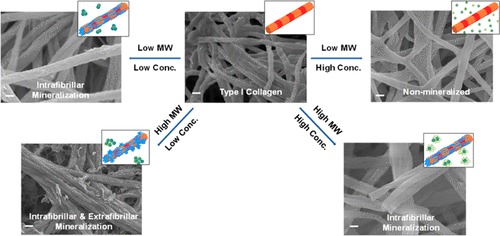当前位置:
X-MOL 学术
›
ACS Biomater. Sci. Eng.
›
论文详情
Our official English website, www.x-mol.net, welcomes your
feedback! (Note: you will need to create a separate account there.)
Effects of Molecular Weight and Concentration of Poly(Acrylic Acid) on Biomimetic Mineralization of Collagen
ACS Biomaterials Science & Engineering ( IF 5.4 ) Pub Date : 2018-06-29 00:00:00 , DOI: 10.1021/acsbiomaterials.8b00512 Yipin Qi 1 , Zhou Ye 2 , Alex Fok 2 , Brian N. Holmes 2 , Montserrat Espanol 3, 4 , Maria-Pau Ginebra 3, 4, 5 , Conrado Aparicio 2
ACS Biomaterials Science & Engineering ( IF 5.4 ) Pub Date : 2018-06-29 00:00:00 , DOI: 10.1021/acsbiomaterials.8b00512 Yipin Qi 1 , Zhou Ye 2 , Alex Fok 2 , Brian N. Holmes 2 , Montserrat Espanol 3, 4 , Maria-Pau Ginebra 3, 4, 5 , Conrado Aparicio 2
Affiliation

|
Inspired by nature, poly(acrylic acid) (PAA) and other polyelectrolytes have been used as noncollagenous proteins (NCPs) surrogates for biomimetic intrafibrillar mineralization of collagen fibrils and, thus, to model the ultrastructure of bone, to study the mechanism of bone mineralization, and more scarcely to fabricate scaffolds for hard tissue engineering. The objective of this study was to systematically investigate the effect of the molecular weight (MW) and the concentration of PAA on the rate and pattern of biomineralization of collagen matrices. Densified type I collagen films were mineralized in supersaturated PAA-stabilized amorphous calcium-phosphate (PAA-ACP) solutions containing increasing MW (2 kDa, 50 kDa, 450 kDa) and concentrations (10, 25, 50 mg/L) of PAA up to 7 days. The stability and physical properties of collagen-free PAA-ACP solutions were also investigated. In our system, lowering PAA MW and increasing PAA concentration resulted in solutions with increasing stability. Overstable PAA-ACP solutions that fully inhibited mineralization of the collagen matrices were achieved using PAA 2kDa-50mg/L. Conversely, unstable solutions were obtained using high PAA MW at low concentrations. Nucleation and growth of a significant amount of extrafibrillar minerals on the collagen fibrils was obtained using these solutions. In a wide range of combined MW and concentration of PAA, we obtained intrafibrillar mineralization of collagen with hydroxyapatite crystals aligned parallel to the collagen fibril as in natural tissues. Intrafibrillar mineralization was correlated with PAA-ACP stability and growth of the PAA-ACP particles in solution. Our results support using PAA to act as a surrogate to NCPs function as selective inhibitors or promoters of biological mineralization and provide parameters to manufacture new biomimetic scaffolds and constructs for bone and dentin tissue engineering.
中文翻译:

分子量和聚丙烯酸浓度对胶原仿生矿化的影响
受自然界的启发,聚丙烯酸(PAA)和其他聚电解质已被用作非胶原蛋白(NCPs)的替代物,用于仿生胶原原纤维的原纤维内矿化,从而为骨的超微结构建模,研究骨矿化的机理,并且几乎不需要制造用于硬组织工程的支架。这项研究的目的是系统地研究分子量(MW)和PAA浓度对胶原基质生物矿化速率和模式的影响。致密的I型胶原膜在过饱和的PAA稳定的无定形磷酸钙(PAA-ACP)溶液中矿化,该溶液包含增加的MW(2 kDa,50 kDa,450 kDa)和浓度(10、25、50 mg / L)的PAA到7天。还研究了不含胶原的PAA-ACP溶液的稳定性和物理性质。在我们的系统中,降低PAA MW和增加PAA浓度可以使溶液具有更高的稳定性。使用PAA 2kDa-50mg / L,可以完全抑制胶原蛋白基质矿化的超稳定PAA-ACP溶液。相反,使用低浓度的高PAA MW可获得不稳定的溶液。使用这些溶液获得了胶原原纤维上大量原纤维外矿物质的成核和生长。在广泛的结合分子量和PAA浓度的广泛范围内,我们获得了胶原的纤维内矿化作用,其羟基磷灰石晶体与天然组织中的胶原纤维平行排列。纤维内矿化与溶液中PAA-ACP的稳定性和PAA-ACP颗粒的生长相关。我们的研究结果支持使用PAA替代NCP充当生物矿化的选择性抑制剂或促进剂,并为制造新型仿生支架和用于骨骼和牙本质组织工程的构建体提供参数。
更新日期:2018-06-29
中文翻译:

分子量和聚丙烯酸浓度对胶原仿生矿化的影响
受自然界的启发,聚丙烯酸(PAA)和其他聚电解质已被用作非胶原蛋白(NCPs)的替代物,用于仿生胶原原纤维的原纤维内矿化,从而为骨的超微结构建模,研究骨矿化的机理,并且几乎不需要制造用于硬组织工程的支架。这项研究的目的是系统地研究分子量(MW)和PAA浓度对胶原基质生物矿化速率和模式的影响。致密的I型胶原膜在过饱和的PAA稳定的无定形磷酸钙(PAA-ACP)溶液中矿化,该溶液包含增加的MW(2 kDa,50 kDa,450 kDa)和浓度(10、25、50 mg / L)的PAA到7天。还研究了不含胶原的PAA-ACP溶液的稳定性和物理性质。在我们的系统中,降低PAA MW和增加PAA浓度可以使溶液具有更高的稳定性。使用PAA 2kDa-50mg / L,可以完全抑制胶原蛋白基质矿化的超稳定PAA-ACP溶液。相反,使用低浓度的高PAA MW可获得不稳定的溶液。使用这些溶液获得了胶原原纤维上大量原纤维外矿物质的成核和生长。在广泛的结合分子量和PAA浓度的广泛范围内,我们获得了胶原的纤维内矿化作用,其羟基磷灰石晶体与天然组织中的胶原纤维平行排列。纤维内矿化与溶液中PAA-ACP的稳定性和PAA-ACP颗粒的生长相关。我们的研究结果支持使用PAA替代NCP充当生物矿化的选择性抑制剂或促进剂,并为制造新型仿生支架和用于骨骼和牙本质组织工程的构建体提供参数。











































 京公网安备 11010802027423号
京公网安备 11010802027423号